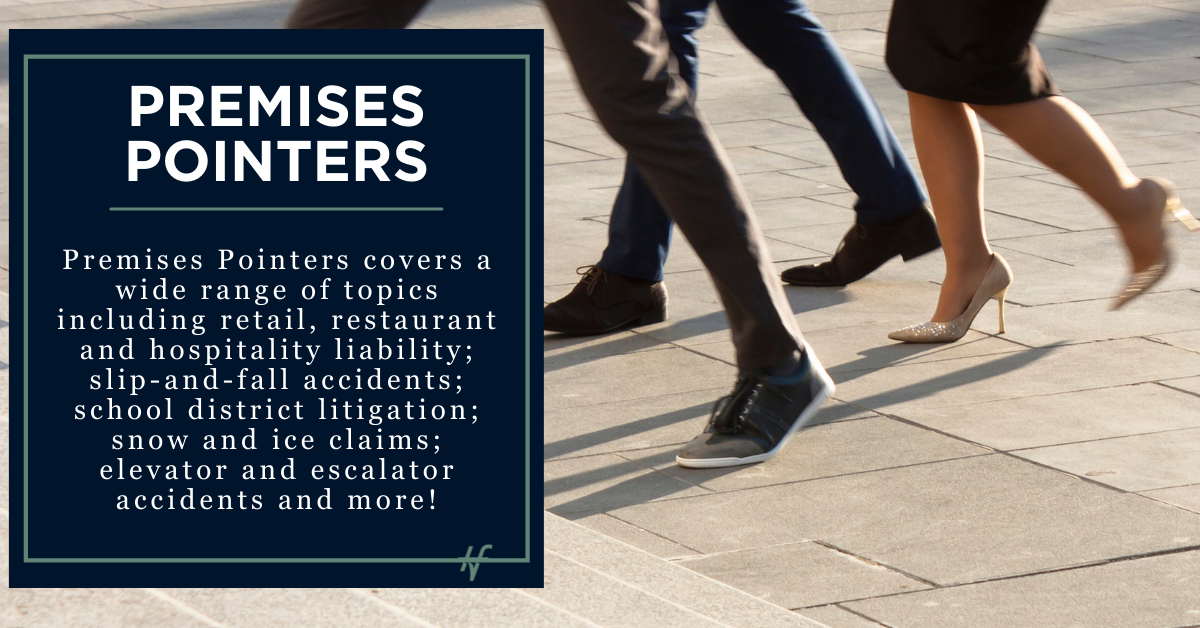|

Retail, Restaurant and Hospitality Happenings Around New York State and Beyond
By: Jody E. Briandi [email protected]
9/26/25 Mahoney v. Whole Foods Grp., Mkt. Inc.
United States District Court, Eastern District of New York
Plaintiff’s attempt in this slip and fall case to prevail on a novel legal theory based on NY Labor Law Section 376 was unsuccessful because plaintiff was not within the class the statute was designed to protect.
Plaintiff Deborah Mahoney filed a negligence action against Whole Foods Market Group, Inc. after slipping and falling at a Whole Foods store. The claims included common law negligence and an alleged violation of NY CLS Labor § 376, which requires mercantile establishments to maintain safe conditions for employees and persons "frequenting" the premises. As often seen with retail cases, the case was removed to federal court based on diversity jurisdiction. Plaintiff, who had shopped at the store only a few times before the incident, slipped and fell near the fish counter, allegedly due to water on the floor. After the fall, Plaintiff noticed water on the floor and wet clothes, but there was no evidence of how long the water had been present or how it got there. Store management was unaware of prior similar incidents or leaks in the area.
Whole Foods moved for summary judgment on the negligence claim, arguing lack of actual or constructive notice of the hazardous condition. Plaintiff opposed, arguing that summary judgment should only address notice, not the entire negligence claim, and that she should be allowed to proceed on a theory that Whole Foods created the hazard. Plaintiff also argued that NY CLS Labor § 376 provided a private right of action for her injuries. The court granted summary judgment for Whole Foods on the negligence claim, finding no evidence that Whole Foods had actual or constructive notice of the hazardous condition. The court later clarified that summary judgment was also appropriate on the issue of whether Whole Foods created the hazard, as Plaintiff failed to provide evidence of any affirmative act by Whole Foods that created the dangerous condition. Mere speculation or the fact that the store used a seafood display with ice was insufficient. The court dismissed the claim under NY CLS Labor § 376. It was determined that section 376 does not provide an express or implied private right of action for customers like Plaintiff, as she did not "frequent" the store within the meaning of the statute (having only visited "a few times" and not "often or habitually"). The court found Plaintiff was not within the class of persons the statute was intended to protect.
9/26/25 Almodovar v. Wal-Mart Stores E., LP
United States District Court, Southern District of New York
Retailer’s motion for summary judgment was granted based on plaintiff’s failure to meet her burden of proof and the lack of evidence establishing actual or constructive notice, as well as evidence to support a failure to inspect theory.
Plaintiff Jarline Almodovar slipped and fell in a Wal-Mart store in Middletown, New York, while shopping with her husband. The incident occurred near a self-service water filling station and an area where dishwashing liquid is sold. After the fall, water was observed on the floor, but neither Almodovar nor her husband saw the water before the accident or knew how it got there or how long it had been present.
The water was described as clear, with no track marks, footprints, or debris. There was no evidence regarding the frequency of employee presence in the area or any prior complaints or observations of the water.
Plaintiff claimed that Wal-Mart was negligent in maintaining the premises, leading to the slip and fall. Focus was placed on whether Wal-Mart had constructive notice of the water hazard, arguing that the location was one where employees should have seen and remedied the condition. Plaintiff also advanced a "failure to inspect" theory, suggesting that a reasonable inspection would have revealed the hazard. Wal-Mart argued there was no evidence it created the hazardous condition, had actual notice, or had constructive notice of the water on the floor. Further, Wal-Mart contended that the water was not visible and apparent prior to the fall, and there was no evidence regarding how long it had been present or that any inspection policy was violated.
The court determined that there was no evidence presented that Wal-Mart or its employees affirmatively created the water hazard. The mere presence of a self-service station did not establish creation of the hazard. There was also no evidence that showed that Wal-Mart had actual notice of the water, as there were no prior reports or observations by employees. Finally, the court found no evidence that the water was visible and apparent before the fall, as neither the plaintiff nor her husband saw it beforehand. There was also no evidence of footprints, track marks, or other indicators suggesting the water had been present for a significant period. As for the failure to inspect theory, plaintiff failed to provide evidence of a required inspection policy or that a reasonable inspection would have discovered the water. The court noted that the burden was on the plaintiff to show that a reasonable inspection would have revealed the hazard. Accordingly, the court granted summary judgment in favor of Wal-Mart, finding that the plaintiff failed to raise a genuine issue of material fact regarding Wal-Mart's creation of the hazard, actual or constructive notice, or failure to inspect.
9/23/25 Peters v. Whole Foods Mkt. Grp., Inc.
United States District Court, Southern District of New York
Retailer’s motion for summary judgment was denied based on questions of fact raised by video surveillance showing another customer slip in the area in question 13 minutes before the plaintiff’s fall.
The plaintiff, Florence Peters, brought a negligence action against Whole Foods after slipping and falling in a Whole Foods store. Peters alleged that she slipped on a wet or slippery condition near the hot food bar while purchasing lunch. Whole Foods moved for summary judgment, arguing that there was no evidence it had actual or constructive notice of the hazardous condition. Whole Foods contended that it had no notice of any wet or slippery condition, citing routine inspections and the absence of reported spills or abnormalities in the 20 to 30 minutes before the incident. The plaintiff, however, argued that video footage showed visible and apparent puddles of water around the hot food bar, that another customer slipped in the same area approximately 13 minutes before her fall, and that a Whole Foods employee was present in the area and had the opportunity to observe and remedy the condition. The plaintiff also challenged the credibility of Whole Foods’ inspection log, asserting that the video did not show an inspection at the time indicated. The court found that, although some of the plaintiff’s arguments were speculative, such as interpreting post-accident pointing in the video as evidence of pre-existing wet spots, a reasonable jury could find that a wet or slippery condition existed for at least thirteen minutes prior to the plaintiff’s fall, based on the video evidence of another customer slipping and the presence of a Whole Foods employee in the area. The court noted that New York case law varies on how long a dangerous condition must exist to establish constructive notice, but found that the circumstances here raised a genuine issue of material fact. The adequacy and timing of Whole Foods’ inspection were also deemed factual questions for the jury. As a result, the court denied Whole Foods’ motion for summary judgment, finding that material issues of fact remained regarding constructive notice and the adequacy of inspection.
8/27/25 Crawford v. Walmart Inc.
United States District Court, Eastern District of New York
Retailer’s motion for summary judgment granted due to no proof of when the condition was created, how it was created or notice to defendant it existed.
Plaintiff Crawford slipped on a black, wet substance in an aisle while shopping. She did not see the substance before her fall and did not know how it came to be there or how long it had been present. An eyewitness observed a skid mark and oily substance on the floor after the incident but did not know how long it had been there or how it got there. Walmart employee observed "something" on the floor after being alerted to the incident but did not investigate further. No video footage of the incident was available. Walmart moved for summary judgment, arguing that Plaintiff could not establish that Walmart created the hazardous condition or had actual or constructive notice of it. Walmart stressed that Plaintiff and witnesses only observed the substance after the fall, and that photographs did not show evidence (such as other footprints or cart tracks) indicating the substance had been present for a significant period. Plaintiff opposed summary judgment, arguing that there was "direct and inferential evidence" of constructive notice. She claimed the substance was visible and apparent, citing witness observations and photographs taken after the incident. She further argued that photographs showed trails from shopping carts and footprints, suggesting the condition existed for a significant period. Finally, she asserted prejudice due to Walmart's failure to preserve video footage, claiming this hindered her ability to uncover additional facts. The court found no evidence that the substance was visible and apparent before the fall; all observations occurred after the incident. The court held that the mere existence of a foreign substance, without more, is insufficient to support a negligence claim. As for the argument the video was not preserved, the court rejected it, noting that no video existed and Plaintiff did not develop this argument or request relief. The court granted summary judgment to Walmart.
|





